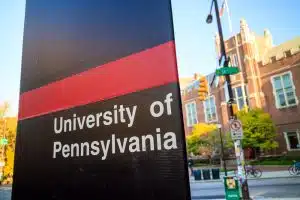UPenn Waitlist Acceptance Rate: Stats and Tips
Understanding the acceptance rate from the UPenn waitlist can significantly impact your college admission strategy. If you’re on this waitlist, it’s essential to know the next steps to take.
The University of Pennsylvania’s latest overall acceptance rate is only 5.8%, highlighting its competitive nature. However, this rate differs from those specifically for waitlisted students.
This guide is here to help you if you’re waitlisted. It offers key statistics on waitlist acceptance and practical tips to boost your chances of getting in.
What Is UPenn’s Waitlist Acceptance Rate?
The latest UPenn waitlist acceptance rate, notably for the Class of 2026, is 5.9%. This rate offers insight into the selectivity for waitlisted candidates.

This table showing acceptance rates over the past five years highlights shifts in UPenn’s admissions strategy:
| Class | Students Waitlisted | Students Confirmed on Waitlist | Students Accepted | Waitlist Acceptance Rate |
| Class of 2023 | 2932 | 2051 | 101 | 4.9% |
| Class of 2024 | 3205 | 2350 | 391 | 16.6% |
| Class of 2025 | 3933 | 2753 | 121 | 4.4% |
| Class of 2026 | 3351 | 2508 | 147 | 5.9% |
| Class of 2027 | To be released | To be released | To be released | To be released |
The Class of 2024 saw a notable jump to 16.6%, an anomaly in an otherwise consistent pattern. This fluctuation points to UPenn’s varying admissions needs each year.
The average acceptance rate for waitlisted students over these years is about 7.95%, a figure that balances periods of higher flexibility with times of stricter selection. This average is useful for setting realistic expectations if you are on the waitlist.
Moreover, the sharp increase for the Class of 2024 likely reflects a response to unique circumstances, such as enrollment uncertainties. The general downward trend, aside from this spike, suggests increasing competitiveness and selectivity at UPenn.
Understanding these dynamics is essential for any student on the waitlist, aiming to turn their waitlist status into an acceptance.
What Does It Mean to Be on UPenn’s Waitlist?
Being on UPenn’s waitlist means you’ve qualified as a potential student but haven’t been directly offered admission due to space limitations. You’re part of a reserve pool of candidates who might fill slots if admitted students decline their offers. This system lets UPenn maintain precise control over its class size and composition.
The selective nature of the UPenn waitlist underscores the competitiveness among candidates. Universities like UPenn use waitlists to meet their enrollment targets, adjusting for the number of admitted students who ultimately decide to enroll.
How Does UPenn Approach the Waitlist?
UPenn manages its waitlist with clear, straightforward communication. As a waitlisted student, you must accept the waitlist offer via the Penn Applicant Portal to be considered for any openings.
The selection from the waitlist is methodical, not random. UPenn carefully reviews waitlisted applicants as spots in the incoming class become available, ensuring that those accepted will complement the existing class makeup.
Why You Might Have Been Waitlisted by UPenn
Getting placed on UPenn’s waitlist can be influenced by a mix of institutional needs and specific elements of your application. Here are the five main factors:
1. Class size limitations
Class size limitations are a primary reason you might end up on the waitlist at UPenn. Like many elite institutions, UPenn has a fixed number of spots available each year. This cap ensures the quality of education and community engagement remains high but means not all qualified applicants can be immediately accommodated.
The strategy behind maintaining specific class sizes directly influences UPenn’s waitlist acceptance rate, as the university strives to ensure an optimal learning environment, highlighting the competitive nature of its admissions process.
2. Desired class composition
Desired class composition is another key factor affecting waitlist decisions at UPenn. The university aims for a diverse and balanced incoming class, considering various elements like academic interests, geographic origins, and extracurricular strengths. This diversity enriches the campus culture and learning experience but complicates the admissions process.

The commitment to diversity and balance means that even outstanding candidates might not be immediately accepted, as admissions officers work diligently to assemble a class that meets all institutional priorities.
3. Yield prediction variances
Yield prediction variances significantly influence waitlist decisions. Universities like UPenn estimate the percentage of accepted students likely to enroll, a figure that can vary each year. This unpredictability affects how many students are admitted directly and how many are placed on the waitlist.
When actual enrollments deviate from these predictions, UPenn may adjust the number of students it accepts from the waitlist, reflecting the dynamic nature of college admissions and the meticulous planning involved in forming a new class.
4. Strength of the applicant pool
The strength of the applicant pool is a critical factor influencing waitlist decisions at UPenn. In years when the pool is exceptionally strong, even top-notch applications might not stand out enough for immediate acceptance. This high level of competition means that being waitlisted is not a reflection of your inadequacies but rather the relative strength of your peers.
This intense competition directly affects the UPenn waitlist acceptance rate. As the quality of applications rises, the university faces tougher choices, leading to more qualified candidates being placed on the waitlist. It underscores the importance of not just being excellent but also distinctive in your application.
5. Gaps in your application
Gaps in your application can also lead to being waitlisted. If your application doesn’t clearly showcase your achievements, goals, or fit with UPenn, the admissions committee might hesitate to offer immediate acceptance. These gaps can range from unclear essays to less detailed descriptions of your extracurricular activities, leaving questions about your potential contributions to the campus.
Addressing these gaps after being waitlisted can significantly impact your chances of acceptance. UPenn allows waitlisted applicants to submit additional information that highlights recent achievements or further clarifies their fit with the university. This opportunity to fill in the blanks can turn a waitlist position into an acceptance, offering a second chance to make a strong impression.
What to Do if You’re Waitlisted by UPenn
If you find yourself on UPenn’s waitlist, don’t lose hope—there are strategic steps you can take to improve your chances of acceptance. Here are six main tips:
1. Respond promptly to the waitlist offer.
Acting quickly when you receive a waitlist offer from UPenn is a key step in showing your keen interest in joining their academic community. It’s important because it puts you in a favorable position for potential acceptance. When you confirm your spot on the waitlist, you’re telling the admissions committee that you are still committed to attending their university.
Responding without delay is not just a formality—it’s a strategic action. It shows UPenn that you are enthusiastic about the possibility of attending, despite the current uncertainty. This eagerness could influence the admissions committee’s decision when they review waitlisted candidates.
2. Update UPenn with any significant achievements.
If you’ve achieved something notable since your original application, updating UPenn can significantly strengthen your standing on the waitlist. Whether it’s new awards, improved grades, or other accomplishments, sharing these updates gives the admissions committee a fuller and more current view of what you bring to the table.

It’s crucial to focus on substantial achievements that reflect real progress or important milestones in your academic or personal development. This sends a clear message to UPenn about your dedication to continual growth and excellence. Remember, significant updates can positively impact your chances of moving from the waitlist to the acceptance list, as they underscore your ongoing commitment to reaching higher.
3. Write a letter of continued interest.
Crafting a letter of continued interest is a great way to show UPenn that you are still enthusiastic about the possibility of joining their community. This letter is your chance to explain why UPenn remains your top choice and how you see yourself contributing to the campus.
Be specific about the programs, courses, and elements of campus life that excite you. This detail shows that your interest is deep and well-informed.
A well-written letter of continued interest can make a real difference. It transforms you from just another applicant on the waitlist into a proactive candidate with a clear vision for your future at UPenn. This personal approach can be very persuasive in a competitive admissions process.
4. Request an additional recommendation letter.
Asking for an additional recommendation letter can provide UPenn with fresh insights into your character and accomplishments. Select someone who can discuss aspects of your personality or achievements that were not emphasized in your initial application. This could be a recent teacher, employer, or mentor who knows you well and can speak to your growth and potential.
This new letter adds depth to your application and can help you stand out among other waitlisted candidates. Make sure UPenn is open to receiving extra materials before sending this letter. If they are, this recommendation can further demonstrate your strong interest in the university and your qualifications for admission.
5. Keep your grades up.
It’s essential to maintain your academic performance after being placed on the waitlist. Keeping your grades up demonstrates to UPenn that you are committed to academic excellence and capable of handling their challenging coursework. High and consistent grades are strong indicators of your ability to thrive in a demanding educational setting.
Maintaining excellent grades also shows resilience and dedication. It signals that you remain focused on your educational goals, despite the uncertainty surrounding your admission. If you have improved your grades significantly since your initial application, be sure to share this with UPenn.
This update can positively influence your status on the waitlist, as it showcases your continued academic growth and potential, which are key qualities that prestigious institutions like UPenn seek in their students.
6. Consider your plan Bs seriously.
While waiting on the UPenn decision, it’s wise to thoroughly explore and commit to your backup plans. This doesn’t mean losing hope but preparing yourself for any outcome. Having solid alternatives can ease the stress and uncertainty of being on the waitlist.
By securing strong backup options, you maintain a positive and proactive outlook on your future, ensuring you’re well-prepared regardless of the decision. This approach also puts you in a stronger position to choose the best path for your education and career goals, without the pressure of the unknown.
Moreover, actively considering different paths highlights your openness and flexibility—qualities that are invaluable in your academic and professional life. Adopting this perspective can greatly enhance your ability to handle the college admissions process confidently and optimistically.
How to Handle UPenn Waitlist Rejection
If you face rejection from UPenn’s waitlist, it’s essential to have a plan to process and move forward constructively. Here are five steps to help you navigate this situation:

1. Allow yourself to feel disappointed.
It’s natural to feel disappointed after not making it off the waitlist, especially from a place as renowned as UPenn. Recognize these feelings as part of the process and understand that it’s completely okay to be upset.
This isn’t about giving up on your dreams. It’s about acknowledging your emotions so that you can move forward with clarity and resilience, ready to face new opportunities and challenges.
2. Reflect on your application.
Taking a close look at your application is essential. Review everything you submitted, from essays to extracurricular activities, and assess it as objectively as possible. Identify what worked well and what could be improved.
This reflection is crucial, not for dwelling on past setbacks but for making positive adjustments that can enhance your future applications, whether for other colleges or for a potential transfer.
3. Reassess your goals.
After a rejection, it’s a good idea to reassess your goals. Sometimes, not getting what we want opens the door to unexpected possibilities. Consider whether UPenn was truly the best match for your aspirations, or if there might be other schools that align more closely with your goals and values.
This doesn’t necessarily mean changing your ambitions but refining your approach towards achieving them. Through this process, you might discover new interests or reaffirm your commitment to your original path, either way fostering personal growth and clearer direction for your educational and career objectives.
4. Seek feedback.
Taking the initiative to seek feedback is an important step in personal and academic growth. Reach out to counselors or teachers for insights on your application. Their feedback can provide a fresh perspective on areas to improve and strengths you might not have fully recognized. This is a constructive approach to learning from your experience and enhancing your future applications
Being open to critique and ready to apply the advice you receive is essential. Constructive criticism is invaluable for honing your approach, whether for future college applications, scholarship opportunities, or other academic endeavors. Embrace this opportunity to refine how you present yourself and your achievements.
5. Explore and commit to your next best option.
Embrace your future with optimism by exploring and committing to your next best option. Whether that’s attending another university that has offered you admission or taking a gap year with specific goals, fully commit to your chosen path. This is not just a fallback plan; it’s a strategic decision to pursue excellence and personal growth in a new environment.
This step is about moving forward and making the most of new opportunities. Remember, success and fulfillment can be found in various settings. Though your journey might take an unexpected route, it still holds the potential for significant achievements and rewarding experiences.
Is It Impressive to Get Waitlisted by UPenn?
Being waitlisted by UPenn indeed reflects your strong potential as an applicant, which is an accomplishment. However, it’s important to stay realistic about the likelihood of moving off the waitlist, given the competitive nature of admissions.

While it’s commendable to be waitlisted, it’s also wise to keep an open mind and consider all your college options. This approach ensures you are prepared for any outcome, maintaining a proactive stance during this uncertain period.
Does UPenn Rank Students on Waitlist?
UPenn does not rank its waitlisted students. Instead, the admissions committee takes a fresh look at the applications of those who have accepted the waitlist offer as spots become available. This method ensures that each candidate’s application is considered thoroughly and holistically.
When Will UPenn Release the Waitlist Admission Decision?
Waitlisted students at UPenn can expect to start hearing back about admissions decisions as early as May, with updates continuing on a rolling basis through June. This schedule allows the university to gauge the size and needs of its incoming class accurately, extending offers as and when spaces become available.
It’s important for waitlisted students to understand that this process can extend until the end of June, making it essential to have a robust backup plan due to the prolonged uncertainty.
Conclusion
Navigating the challenges of the UPenn waitlist and its acceptance rate is a test of persistence, reflection, and growth. Remember that the outcome does not define your worth or potential. Success comes in many forms, and sometimes a rejection can be a step closer to the right opportunity for you.
Treat this experience as an opportunity to learn and adapt. Whether your path leads you to UPenn or another destination, your journey is uniquely yours. Continue forward with resilience and optimism, ready for the great opportunities that lie ahead.





































